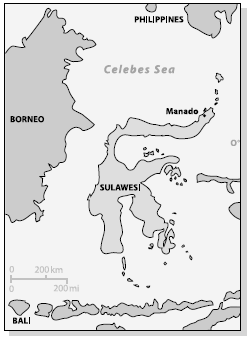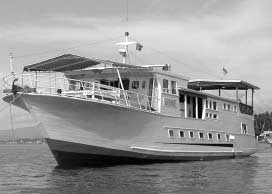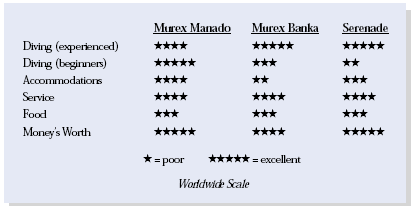North Sulawesi, IndonesiaContents of this Issue: Thumbs Up for the Nautilus Explorer, Thumbs Down for an Undercurrent Poseur Cream Wards off Jellyfish Stings, Stanford Study Suggests Diving Is Not For Everyone, Thankfully Oceanic Objects to Review of Veo 250 Subscriber Asks: Did I Get Gouged? Editorial Office: Ben Davison Publisher and Editor Undercurrent 3020 Bridgeway, Suite 102 Sausalito, CA 94965 diving by land and sea from the August, 2004 issue of Undercurrent
Dear Fellow Diver, If you ask a well-traveled diver from Europe or Asia, you’ll hear that Manado, Indonesia, is high on their list of dive destinations. The area has exceptional marine species diversity, with big schools of fish, tiny critters, and a well-developed dive industry. If you can afford the Caribbean, put this on your radar screen. I flew there for $1,100 from San Francisco and lived well and dived extensively for four weeks for $150/day, and I paid a single-traveler premium. If you can afford the money, can you afford the time? Getting there took me 30 hours with a layover. I had been to the Murex (Manado Underwater Exploration) resort three years ago and decided to return to dive Bunaken Marine Park, Bangka and Talise Islands, the Lembeh Strait, and the Sangihe Islands. Manado is the largest city in Northern Sulawesi and 95% of its residents are Christians, who live peacefully with the remaining 5% Muslims, and there is no fear of terrorism. Although I arrived by noon, after a cumbersome immigration process and a drive through dreadful traffic to the resort, all I could do was crash to recover from my arduous coach flight and 10-hour time differential. Murex was founded in 1987 by Dr. Han Batuna, who studied at Tulane and later headed the Manado Public Health Department, where he set up a recompression chamber. He was present daily; his son-in-law, Danny, an American, now manages the resort. Murex’s grounds are filled with jungle growth, lots of orchids, big koi ponds, flowing streams, and noisy waterfalls. My splendid air-conditioned duplex bungalow, about 50 yards from a gravel beach, had lots of skylights, walls with huge panes of tinted glass, white plaster and hardwoods and white tile floors. I had a king-sized bed, a small refrigerator mini-bar, and an American bathroom. Wandering geckos eliminated any insect problem.
Diving in the Bunaken Marine Park mainly means drift dives on walls (40-80 foot visibility), with slight currents that change direction. Bottom times were usually 60 minutes or 600 psi, and the guides -- all are fluent in English -- recommended a maximum depth of 100 feet, down to 70 feet on the third dive. I often exceeded those depths, and only once was motioned to come up a bit. Divemaster Tono, stocky and strong, was a free spirit who easily could be encouraged to push the envelope. Pangulingan is probably the most advanced dive site in the park, with irregular up, down, and eddy currents. A concave wall leading to a current-swept slope can create problems if one isn’t careful. But here I encountered great schools of chevron barracuda and big-eye trevallies that came within a few feet of me. While buddies weren’t assigned, during current dives they expected us to stay within sight of the group. We cut one dive short here because three divers got carried away, and the divemaster wanted to ensure that the boat got to them. It did. Barracuda Point had strong currents and big fish, such as schooling big-eyes too numerous to count. On one dive, 15 bump-nose (buffalo) parrotfish circled me, and huge schools of black snappers, chevron barracuda, and a large school of oriental sweetlips made the dives fascinating. A very big blue-fin tuna made two passes. Thrilling diving, indeed. Of course, there are excellent critter sites (they could use more), such as Molas wreck (visibility 10 feet) and Bethlehem (an acronym for “Better than Lembeh,” a neighboring area and resort), a shallow bay with a sand and silt bottom. At 90 feet I saw the remarkable lacy scorpionfish (Rhinopias aphanes) and then moved shallower to see a weedy scorpionfish (R. frondosa) and a zebra-striped juvenile Batavian batfish. Then I worked my way up to sea-grass at 25 feet where I was delighted with four kinds of seahorses, helmut gurnards, Napoleon snake eels, ornate ghost pipefish, robust ghost pipefish, baby cuttlefish, juvenile white-eyed and snowflake morays, tons of lionfish, Pegasus seamoths in pairs, decorator crabs with fire urchins or anemones glued to their backs, and all sorts of other critters. Great macro stuff. Meals were satisfying but unimaginative. Lunch on the boats was typically steamed rice; a steamed vegetable dish; and chicken, meat, and fish dishes, followed by fresh fruit. Dinner was served at 7 p.m. Similar to lunch, but it included soup, a larger assortment of dishes, and some sort of cake with a fresh fruit cocktail. This was a time when the international guests -- British, Dutch, German, Chinese (Hong Kong), Singaporese, Japanese, and even a dozen American rebreather divers there for technical diving -- swapped stories with whomever shared a common language and reviewed digital images and videos on the lobby TV. After several days, they ferried me to their Bangka annex, a beautiful threehour ride via their covered diveboat (plus additional time for a couple of dives). This is an isolated resort, with five bungalows for couples and one for four or more divers. Perched on a pretty crescent-shaped white shell beach, it offers excellent swimming and snorkeling. The generator is within earshot; there is no air-conditioning (a portable fan was available) or hot water at night; and the overhead light is weak, so no reading unless you bring your own Itty Bitty Book Light (available in most bookstores). I got head bumps on the low doorways in the middle of the night when going out to use the Balinese-style bathroom. The food is about the same as at the main resort; the dive boats and guides are often the same; and the air fills are still 3,000 psi. Most sites are pinnacles, rocks, and seamounts, usually less than a 10-minute ride. I had spectacular soft coral dives, especially in the late afternoon among glorious tubastrea polyps. I saw pygmy seahorses (mostly red but some yellow) at nearly every site. Batu Gosoh was a collection of pinnacles, rocks, and crazy currents -- up, down, and all around. Tanjung Arus, a 50-minute boat ride, is a seamount starting at 30 feet with a beautiful cavern at 65 feet running through it. The entrances provide quite a bit of ambient light. Sadly, here was the first tragedy in my diving career. I was with a group of Jakarta divers, although divemaster Tono and I were off alone. Near the end of the dive, a crew member free dove down, frantically signaling Tono to surface. He returned, giving me the same signal. Aboard the boat, a diver lay unconscious. He had descended to 70 feet, where he lost consciousness and his dive buddy lifted him to the surface. One of his buddies, a physician, administered oxygen and tried to resuscitate him. He didn’t succeed. It was difficult to witness, and no one knew what went wrong. We returned to Bangka, and the three survivors went back to Manado with their fallen comrade. I returned to Murex the next day, making three good dives along the way. I’d been here for 12 days, and my next step was to board one of Murex’s liveaboards, the Serenade, for a six-night journey. A German couple and three Swiss divers would be my companions. They preferred to converse in German, though they occasionally switched to English to include me. At 9 p.m., we were ferried by a small inflatable to the Serenade. I was assigned cabin two, one of two side-byside staterooms (which share air-conditioning controls and with only a scanty blanket and neighbors who kept the cabins freezing, I often woke up chilled) with a double bed lower bunk and a single bed upper bunk. Both bunks were close to seven feet long and had reading lights. My large en-suite bathroom had a conventional flush toilet. One stateroom below decks lacks a head; the choice Stateroom 1 is in front and runs the width of the boat. The dining room also runs the width of the boat, with two tables each seating six. We ate at one, and the other held coffee, tea, and snacks and doubled as a camera table. The wooden Serenade, designed by the Murex owners for people under six feet, rolls easily in any kind of seas and produced unwelcome rattles from doors and windowpanes. I jury-rigged solutions. In my stateroom, engine and generator noises were muted, and I lost no sleep.
After a mediocre dive in water colder than usual (81F -- am I getting wimpy?), the engineer was working on the engines so seven of us and a boatman jammed into the inflatable for a slow ride around the island to the next site. We had water up to mid-shin, and the boatman was busily bailing. At the site, three divers threw their inflated BCs over the side and jumped in to don them. Then I and the others slipped into our BCs and back-rolled into the water, which had dropped to 79F. Another mediocre dive, so we started the safety stop after 50 minutes. Getting back in the inflatable was challenging, but more challenging was motoring back to the Serenade against increasing winds. I wore my mask to protect against the heavy rain, and Kennedy the boatman constantly bailed while we divers sat and shivered.
That night we journeyed north to Biaro and Ruang Islands. The dives were excellent; the visibility better; and gilded triggerfish, two tone dartfish, striped surgeonfish, turtles, Napoleon wrasses, and elegant dartfish abounded. Next day it was a dive at Mahengetang Island, site of an active underwater volcano. Several dogtooth tuna cruised the site along with a huge school of big-eye trevallies. There were lots of midnight snappers and several varieties of unicorns (big-nosed, sleek, and ring-tailed). At the end of the dive, rocks were covered with red algae and bubbles of hot gas were percolating. The water temperature climbed to 86F. On our final day, we returned to Barracuda Point for my best dive here. Then, on the slow Serenade, we headed home, arriving at 5:30 at Murex. It was already getting dark. Danny, the resort manager, told me that my van was waiting for me and to just load my stuff aboard and the driver would take me to my next stop, Lembeh resort, three hours away. I got my suitcase out of the dive center, pointed out my other stuff from the Serenade, and stopped at the office to pay my bill. Lembeh Resort, which uses these folks to manage its dive operation, was the next stop. That review comes next time. -- J.J.
|

I want to get all the stories! Tell me how I can become an Undercurrent Online Member and get online access to all the articles of Undercurrent as well as thousands of first hand reports on dive operations world-wide
| Home | Online Members Area | My Account |
Login
|
Join
|
| Travel Index |
Dive Resort & Liveaboard Reviews
|
Featured Reports
|
Recent
Issues
|
Back Issues
|
|
Dive Gear
Index
|
Health/Safety Index
|
Environment & Misc.
Index
|
Seasonal Planner
|
Blogs
|
Free Articles
|
Book Picks
|
News
|
|
Special Offers
|
RSS
|
FAQ
|
About Us
|
Contact Us
|
Links
|
3020 Bridgeway, Ste 102, Sausalito, Ca 94965
All rights reserved.

 After a solid sleep, I enjoyed a hearty
breakfast -- pancakes, eggs, hot noodles, and
fresh pineapple and papaya -- served overlooking
the beach and distant islands. About
7:30 a.m., I headed for the dive shop. A
board tells you your boat, dive leader, destination,
and departure time. Murex offers
two and three tank trips and shore dives on
the house reef (they ask newcomers to do a
guided house reef dive for starters).
Depending upon your itinerary, you may leave
between 8 a.m. and 9 a.m. and return between
3 p.m. and 5 p.m. The outboard powered boats
are about 30 feet long and fully roofed with
tank holes inside the gunwales and storage up
front. Some boats did not have heads, so
when no women were aboard, some men just peed
over the stern and other passengers went
swimming. Guides use cell phones to communicate
with the resort.
After a solid sleep, I enjoyed a hearty
breakfast -- pancakes, eggs, hot noodles, and
fresh pineapple and papaya -- served overlooking
the beach and distant islands. About
7:30 a.m., I headed for the dive shop. A
board tells you your boat, dive leader, destination,
and departure time. Murex offers
two and three tank trips and shore dives on
the house reef (they ask newcomers to do a
guided house reef dive for starters).
Depending upon your itinerary, you may leave
between 8 a.m. and 9 a.m. and return between
3 p.m. and 5 p.m. The outboard powered boats
are about 30 feet long and fully roofed with
tank holes inside the gunwales and storage up
front. Some boats did not have heads, so
when no women were aboard, some men just peed
over the stern and other passengers went
swimming. Guides use cell phones to communicate
with the resort.  After a cold breakfast and a
7:15 a.m. briefing, I geared up for
my first dive. Two benches on the
dive deck had six tank holes each
and a storage area above for fins,
lights, and booties. The crew didn’t
organize it well, but tried to
be helpful. I climbed up to the
sun deck and donned my skin, then
climbed down to suit up. Dives
were either off the swim-step or
from an inflatable. At Bangka
Island there was a huge school of
blue-lined snappers, a school of
rainbow runners, a really big mangrove
jack, and a visit from a yellow-
fin tuna. At the end of the dive I encountered a school of big-nose unicorns and Kennedy -- a slight and wiry
guide who seemed genuinely upset if you weren’t having the best time of your life
-- showed us one of the ubiquitous pygmy seahorse seafans. When we returned I
showered next to the camera rinse tank on the swim step and then sat down to
scrambled eggs, bacon, toast, hot noodles, pancakes or French toast, orange juice,
coffee, and tea. By the way, one guest, a depressed pain in the ass, created doom
and gloom with his constant grouching; we had to constantly reassure poor Kennedy
that it was not his fault.
After a cold breakfast and a
7:15 a.m. briefing, I geared up for
my first dive. Two benches on the
dive deck had six tank holes each
and a storage area above for fins,
lights, and booties. The crew didn’t
organize it well, but tried to
be helpful. I climbed up to the
sun deck and donned my skin, then
climbed down to suit up. Dives
were either off the swim-step or
from an inflatable. At Bangka
Island there was a huge school of
blue-lined snappers, a school of
rainbow runners, a really big mangrove
jack, and a visit from a yellow-
fin tuna. At the end of the dive I encountered a school of big-nose unicorns and Kennedy -- a slight and wiry
guide who seemed genuinely upset if you weren’t having the best time of your life
-- showed us one of the ubiquitous pygmy seahorse seafans. When we returned I
showered next to the camera rinse tank on the swim step and then sat down to
scrambled eggs, bacon, toast, hot noodles, pancakes or French toast, orange juice,
coffee, and tea. By the way, one guest, a depressed pain in the ass, created doom
and gloom with his constant grouching; we had to constantly reassure poor Kennedy
that it was not his fault. With a storm
raging to the north,
we altered our
itinerary and moved
south to Lembeh Strait
to dive the Police
Pier, where I saw
juvenile Banggai cardinalfish
hidden in
big black sea urchins
and huge strangely
shaped sand anemones,
orange painted frogfish,
a fingered dragonet,
a juvenile demon
stinger walking on the
sand, a large barramundi, cod and lots of nudibranchs, making it a fine dive. Our
second dive was at Hairball, named for the hairy painted frogfish found there. I
saw clown frogfish and many anemones full of aggressive saddleback clownfish and
Clark’s clownfish. Other clownfish, like the pink, orange, and spine cheeks, were
less likely to defend their anemone. At Nudy Retreat the star critters were yellow
pygmy seahorses, side-by-side cockatoo waspfish, two Pegasus seamoths, a pygmy
pipehorse, pipefish, and just about every variety of nudibranch.
With a storm
raging to the north,
we altered our
itinerary and moved
south to Lembeh Strait
to dive the Police
Pier, where I saw
juvenile Banggai cardinalfish
hidden in
big black sea urchins
and huge strangely
shaped sand anemones,
orange painted frogfish,
a fingered dragonet,
a juvenile demon
stinger walking on the
sand, a large barramundi, cod and lots of nudibranchs, making it a fine dive. Our
second dive was at Hairball, named for the hairy painted frogfish found there. I
saw clown frogfish and many anemones full of aggressive saddleback clownfish and
Clark’s clownfish. Other clownfish, like the pink, orange, and spine cheeks, were
less likely to defend their anemone. At Nudy Retreat the star critters were yellow
pygmy seahorses, side-by-side cockatoo waspfish, two Pegasus seamoths, a pygmy
pipehorse, pipefish, and just about every variety of nudibranch. Diver’s Compass: Twelve nights at the Murex resort and Bangka,
with food, cost me $600; I got credit for dives that I missed in
2001, so diving that would have cost me $1,000 normally was $600;
six days of diving and six nights on the Serenade was $900. ... N.
Sulawesi is mountainous, with lots of big volcanic peaks, and
several resorts in the highlands offering a break from the rather
monotonous year-round, 85-degree air at sea level. Get guides or
go off on your own to climb volcanoes, visit rainforests, tour the
city and the colorful market, and go white water rafting or horseback riding. ...
Transfers between resorts and the airport were included except for a $20 transfer fee
to go to Bangka Island resort. ... There is an $18 Bunaken Marine Park fee and a $10
departure tax. ... I set up my trip through Reef and Rainforest Dive and Adventure
Travel in Sausalito, CA: 800-794-9767, 415-289-1760,
Diver’s Compass: Twelve nights at the Murex resort and Bangka,
with food, cost me $600; I got credit for dives that I missed in
2001, so diving that would have cost me $1,000 normally was $600;
six days of diving and six nights on the Serenade was $900. ... N.
Sulawesi is mountainous, with lots of big volcanic peaks, and
several resorts in the highlands offering a break from the rather
monotonous year-round, 85-degree air at sea level. Get guides or
go off on your own to climb volcanoes, visit rainforests, tour the
city and the colorful market, and go white water rafting or horseback riding. ...
Transfers between resorts and the airport were included except for a $20 transfer fee
to go to Bangka Island resort. ... There is an $18 Bunaken Marine Park fee and a $10
departure tax. ... I set up my trip through Reef and Rainforest Dive and Adventure
Travel in Sausalito, CA: 800-794-9767, 415-289-1760, 